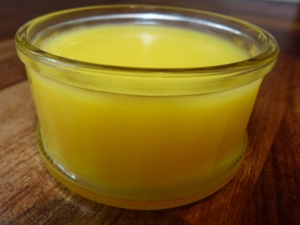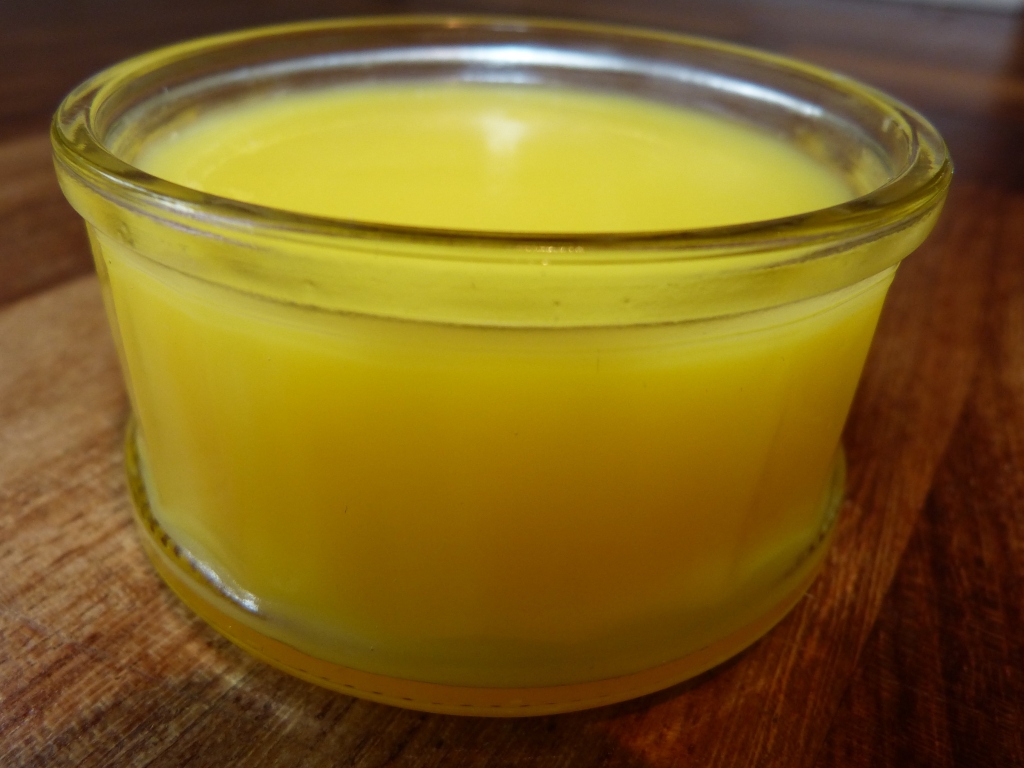 I let you know how good ghee was to cook with, so rather than leaving you in suspense, it makes sense to let you know how to make it!
I let you know how good ghee was to cook with, so rather than leaving you in suspense, it makes sense to let you know how to make it!
Ghee is a form of clarified butter. It is the butter fat without the milk protein so can be used for those avoiding dairy (although not advised for those who are allergic). It is saturated fat so it can be used for cooking without becoming toxic like oils. It has a higher smoke point than butter which means it can be used to cook at a higher temperature without burning. Ghee is also a digestive – it helps with digestion, absorption and assimilation. Here is the recipe for ghee. The recipe makes about 500g of ghee, enough for several pots.

Ghee
Ingredients
- 3 packs unsalted organic butter
Instructions
- Put the butter in a heavy pan. Turn on the heat to medium until butter melts.Turn down the heat until the butter just boils and continue to cook at this heat. Do not cover the pot. The butter will foam and sputter for a while and then begin to quiet down.
- Stir it occasionally.
- In about 35mins after putting the butter in the pan, it will begin to smell like popcorn and turn a lovely golden colour. Whitish curds will begin to form on the bottom of the pot. When these whitish curds turn a light tan color and sink to the bottom, the ghee is ready. At this point, the sound of the cooking will also change from one of boiling to one of frying, and the large bubbling will stop and a very fine froth will appear on top. Do not leave ghee for a long time without checking. Check regularly to see how it is doing as it can turn very quickly.
- Take it off the heat immediately, for the ghee is most likely to burn at this stage – and it burns quickly! Burned ghee has a nutty smell and a dull, slightly brownish colour.
- Let the ghee cool for a few minutes.
- Pour the ghee through a tea-strainer, layers of cheesecloth or just very carefully (leaving behind the curds) into an earthenware, glass or metal container with a tight lid. Discard the curds at the bottom of the pan.
- Ghee can be kept on the kitchen shelf, uncovered. It does not need refrigeration but it can be useful to keep one out on the shelf and the others in the fridge. The medicinal properties are said to improve with age. Don’t spoon out the ghee with a wet spoon or allow any water to get into the container as this will create conditions for bacteria to grow and will spoil the ghee.
Video and photos below to help:

This is the ‘end-point’ for making ghee. When the white buttery looking curds sink to the bottom and the oil turns clear and a warm – golden colour. A very light froth starts to appear on the top.




6 Comments
Basharat · April 12, 2013 at 15:19
Thank you so much Kate discussing about ghee which is THE PUREST FORM and not even fattening as the myth says. In Pakistan the simple folk used ORGANIC things, they did not know about impurities, in their foods….they were much stronger health wise. Our mothers and grand mothers used these…..and so did we. Then with the introduction of these ‘plastic forms’ PURE GHEE became the fashion. Pure ghee was forgotten. People started to find faults with it, smelly, greasy etc. Now I see its revival, and coming from you with all its benefits and uses, I am sure many others will follow. The fact that you have now discovered the ghee and using it yourself is more inviting and trusting. Well done Kate.
The myths of oils & fats - The Ayurveda Practice · December 9, 2014 at 13:25
[…] Dairy fats (butter, ghee) […]
Pantry essentials - The Ayurveda Practice · January 29, 2016 at 08:30
[…] THAN: bad oils. Cook with coconut oil, ghee or virgin olive oil (olive oil only if not heating too high or for too long). Add other virgin oils […]
Boost immunity, reduce stress, stay strong - The Ayurveda Practice · March 13, 2020 at 14:17
[…] nails are short). Put a drop of untoasted, unrefined sesame oil (like Clearspring or Meridian), ghee or even olive oil onto each little finger and insert up your nose (never far enough to cause any […]
Cool inflammation with the ‘quick purge’ - The Ayurveda Practice · February 9, 2021 at 11:55
[…] main ingredients being mung beans (green), split mung dal (yellow), rice, vegetables, spices and ghee (or vegan […]
Fasting - what does Ayurveda say? - The Ayurveda Practice · February 5, 2024 at 09:50
[…] For this, when (and only when) hunger occurs in the morning, drink a volume of ghee (or sesame oil) and wait for hunger to return before eating food. Usually, the most we can stomach […]